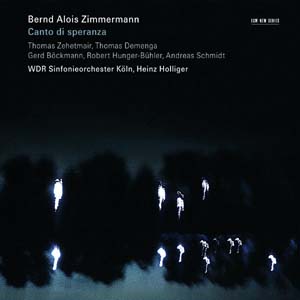 West German composer Bernd Alois Zimmerman is one of those unclassifiable artists whose style progressed through what seems to be the normal twentieth-century pattern: neoclassicism, atonality and the twelve-tone row of Schoenberg, serialism, and finally a kind of polyglot style that resolved into what is known in Germany as “Klangkomposition,” a style marked by planes or blocks of sound, similar to the late music of Claude Debussy and found in one variation or another across Europe, especially in the east among composers as diverse as Krzysztof Penderecki and Arvo Pärt.
West German composer Bernd Alois Zimmerman is one of those unclassifiable artists whose style progressed through what seems to be the normal twentieth-century pattern: neoclassicism, atonality and the twelve-tone row of Schoenberg, serialism, and finally a kind of polyglot style that resolved into what is known in Germany as “Klangkomposition,” a style marked by planes or blocks of sound, similar to the late music of Claude Debussy and found in one variation or another across Europe, especially in the east among composers as diverse as Krzysztof Penderecki and Arvo Pärt.
His Konzert für Violine und Grosses Orchester was “retooled” from a sonata Zimmermann had written when he received a commission from Southwest German Radio. The two outer movements are full orchestrations of the two outer movements of the sonata, while the second movement contains, in addition to the original material, sections newly composed by Zimmermann. Michael Struck-Schloen, in his commentary on the music, notes influences from Bartók, Stravinsky, and Hindemith in the tonalities of the first movement, and they are certainly evident there, and even in the overall shape, fitted seamlessly into a post-Schoenberg context: this is without doubt a mid-twentieth century work, in everything from the orchestral colors to the fevered tension of the solo violin. This work also achieves something that many have tried and many have failed to do: there are passages where the overriding tension gives way to an edgy kind of lyricism and the music soars toward something we can only guess at: don’t ever let anyone tell you that the art of the twentieth century has lost contact with the spirit. Even the quiet passages here have something revelatory about them. I might note that, although the work is in three movements, the “narrative flow,” if I can call it that, is uninterrupted: it is, in concept if not formally, a work based on a single idea, clearly and elegantly expressed. The clarity of that expression doesn’t rest only in the writing: Thomas Zehetmair and the orchestra under Heinz Holliger dig deep into this music and deliver a riveting performance.
Canto di speranza was also reworked some four years after its not-so-great 1953 premiere. Essentially a one-movement concerto for cello and chamber orchestra, this work has gone all the way into serialism, with felicitous results: I have to confess, this is one of the very few serial works I’ve ever been able to stand for any length of time. Struck-Schloen comments on the “vocal” character that Zimmermann intended for the solo cello, and there is definitely that feel to it: the cello not only sings, it speaks, it whispers, and sometimes declaims. The orchestra is an equal partner here — the Brahmsian idea of a concerto as an orchestral work with soloist — and the interplay is beyond engaging — it’s downright fascinating. It becomes not only a showcase for the single voice of the cello, but a group of voices each contributing to a larger and richer dialogue, with each acting in turn as foil and echo of the other. Thomas Demenga’s cello combines tight control with a free-floating lyrical sensibility to provide an affecting experience.
Ich wandte mich. . . . is subtitled “Ekklesiastiche Aktion für zwei Sprecher, Bass-Solo und Orchester,” which in itself gives all sorts of hints as to the nature of this beast: in part, it refers back to seventeenth-century azioni sacre that occupied a space somewhere between (secular) opera and (sacred) church oratorios. It also calls forth the “actions” of Fluxus and other radical artist groups of the 1950s and ’60s, culminating in today’s performance art.
The text, which is of overriding importance in this work, is from Ecclesiastes, which should give you a good idea of the emotional foundation of this piece. (And let me note here that I find Zimmermann’s music to be emotionally highly charged, which is not often the case in post-War Western music.) It’s a work in high contrast, not only in the content — as Struck-Schloen points out, it’s a tension between “artistic rigor and license, hope and terror, God and Antichrist, life and death” — but in its formal outlines. The highly declamatory tone of the bass soloist is set off against almost conversational spoken passages, punctuated by orchestral commentary. The very matter-of-factness of the delivery makes for a devastating performance. The speakers, Gerd Böckman and Robert Hunger-Bühler, and the bass soloist, Andreas Schmidt, seem to have captured the piece precisely, and once again Holliger and the orchestra are right with them. (My one reservation here is that this is a piece that probably needs to be seen as well as heard: the “action” becomes literal at the end of the work.)
I wasn’t familiar with Zimmermann’s music when I encountered this disc, but I have to say this is one of the happier chances in my tenure here. I quite often point out that, even if I didn’t like it, I would feel impelled to have at least some familiarity with the music of the later twentieth century: it is, after all, the music of my time, and has things to say about my world that I should be paying attention to. All I can say with regard to Zimmermann is that he said those things clearly and forcefully and made me want to listen.
(ECM New Series, 2008)
